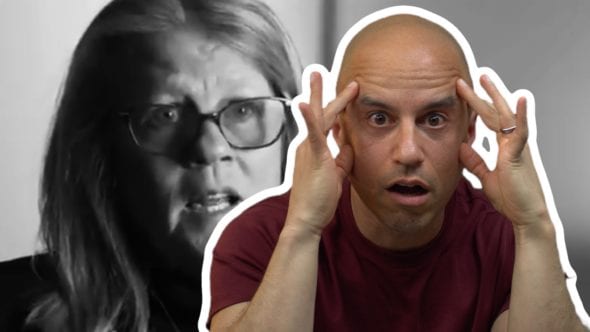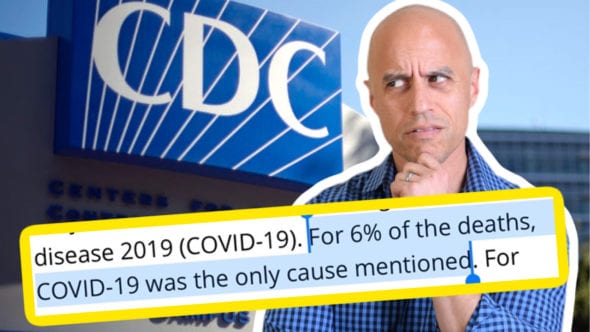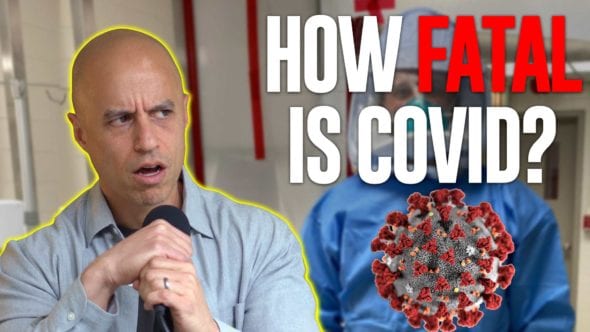Public-private partnerships, genomic epidemiology, and a national EMR among other things made little Iceland a big deal in the science of the pandemic.
Here’s the Nature news article.
Full transcript below!
I wanted to talk today about an article that came out in Nature, talking about Iceland, little Iceland, Reykjavik. You know, the whole Eurovision Fire Saga thing.
Little Iceland, 370,000 people on an Island have scienced the living crap out of COVID from day one and what we can learn in the rest of the world about what they’ve learned and the lessons there.
Now, remember science is one thing. So getting data, trying to find truth, that’s one piece of the puzzle. The second piece then is what is a nation or a culture’s values? What do they wanna do with that scientific understanding and apply it to the problem? So those are separate things, we’re gonna talk about it.
All right, let’s start with this. When the pandemic started, little Iceland realized pretty quickly that it could get overwhelmed. Their hospitals had, you know, machines for testing that were quickly getting overwhelmed by the demand, so what happened is a company called deCODE. DeCODE is owned by Amgen, so it’s a kind of a genomics company. They do genetic analysis, things like that. So they’re based in Reykjavik and what they decided was, well, let’s get involved in this because we can repurpose all our sequencing technology to look at DNA and RNA sequencing and use it on this virus.
So they started spinning up a public private partnership with the Icelandic government, the Directorate of Health, and together, they started sharing lab space, sharing personnel and spinning up testing very, very quickly and not just any old testing, they would sequence the genome, the RNA genome of every single person that tested positive so that they could see what’s the fingerprint of the virus. They took all the data, so they made this widely available to the public and they took that data and it was in a national electronic health record. So one single repository that could then be mined to do science on.
Now, imagine in the US how would we even do that? There’s so many different walled gardens of electronic health record, they don’t communicate with each other. It’s a disaster, but Iceland had this advantage and they had the public private partnership right out the gate. Now, you guys remember what happened in the US, we couldn’t even get testing done, like any hope of suppressing virus, contact tracing, isolating, and testing was gone from the beginning because CDC insisted on doing it and there were these regulatory hurdles to private companies actually doing the job. So by stifling private innovation, we’re already out of the gate screwed up, right? And that’s just a lack of national leadership on every single level and local leadership.
So that being said, the Icelanders figure this out quickly. They start testing everybody and very quickly, you know, after an initial closure for travel and things like that, they started contact tracing and isolating and realizing, okay, okay, stop, stop, stop, stop, stop. Let’s make sure anybody who is positive gets quarantined and isolated for the requisite 14 days. And in the meantime, we’re gonna run a sequence on their genome, and we’re gonna do other analysis on who these people are. What symptoms do they have, who were they in contact with, et cetera. And they were able to get their first wave under control very quickly. They had then a second wave that was smaller in the summer and then a third wave in October, because they’re a country that is dependent on tourism. So they had to open back up to limited tourism with testing we’re gonna talk about that.
So what did they learn? And by the way, they have a mortality of seven per 100,000 from COVID. The United States is 80 per 100,000. So a good, you know, 10 times higher, right? More than 10 times higher mortality. So whatever Iceland did, they had advantages. They were geographically isolated, there were a smaller population, they had a nationalized healthcare system, so they could kind of control everything and they had this public-private partnership.
What did they find? Several things. They were one of the first groups to report that 43% of COVID patients had no symptoms at all, they were asymptomatic. Now, why is that important? It’s important because it says you can transmit this without having symptoms, you can be infected and make other people sick without knowing it. And hence you get the super-spreader events and the rapid spread of this respiratory virus. Whereas, you know, people are sitting around, you know, trying to screen based on symptoms It’s not gonna help. You gotta test the hell out of everybody. And you gotta make sure you contact trace, isolate, et cetera, if you want real viral suppression. And again, that’s a values decision that a culture has to make.
So let’s say, you know, you have all that testing. What else did they find out? Now, what they learned is that the symptoms that people were having were different than what CDC was initially kind of really focusing on and WHO, it turns out it was muscle aches, headache and a dry non-productive cough. Those were the big symptoms people were having, fever wasn’t really high on that list. And yet here are these people pointing a temperature gun at your head. Feeling like that’s gonna do a thing, it’s not. So fever was not a huge thing. Now, that second implication that has is, well, if you’re only testing people who have fevers, you’re gonna miss most of the positives, assuming you’re testing at all which the United States wasn’t able to do early on. So they learned that and they taught us that.
The next thing they taught is that when you actually look at what the fatality rate is now, let’s be very careful we’ve talked about this before. There’s case fatality rate, in other words of all the people who actually test positive. In other words, you see they’re coming to you with symptoms or whatever and they’re getting tested and then they test positive, that’s a case, right? How many people are dying? That’s a case fatality ratio. That’s gonna be high and it has been high. But what about the actual fatality in the whole population, people who test positive and who have the disease, but have never been tested? Well, it turns out Iceland tested half its population by the end. And it’s a small population, 370, you know, thousand. But they were able to determine an infection fatality rate, right? So the actual fatality rate in the world of .3%. I’m gonna repeat that, .3.
So Jay Bhattacharya, Eran Bendavid had done studies in the US where they came up with similar numbers. This is actually potentially an accurate number. Now, remember infection fatality right, now, flu is felt to have an infection fatality rate of .1. So this is three times flu, bad, but not catastrophic, but still bad. But is infection fatality rate a function of the virus itself like a fixed property? No, it depends on the rest of your healthcare system, your genetics, your population, how quickly it’s spreading, do you overwhelm? So in New York, in Italy, when the hospitals were getting overwhelmed, the infection fatality rate goes up because people are dying that could have been saved. In Iceland, they had it under control, generally from the beginning they never got overwhelmed and so infection fatality rate low. Also, they’re a genetically homogenous population. What that means in English is that they’re very similar genetically to each other. So it may just be that the Icelanders are less susceptible to death from COVID and we know there is some genetic component there.
So it’s unclear, they’re a younger population. We know that. So that’s already influencing that number and maybe they have less chronic disease I don’t know the exact numbers. So the co-morbidities that make you more likely to die. So infection fatality rate, they found was .3, and that’s been repeated in different parts of the world, but then it’s also been found to be higher in different parts of the world. So again, it’s not a static number it depends on other things.
So they discovered that, now the other the thing they discovered now remember, because they’re not just testing for the yes or no virus, they’re sequencing the entire virus. So they could determine what was going on with spread and what they learned was a lot of the spread from their contact tracing and genetic fingerprinting of the virus was happening in households, within households. So there’d be an introduction maybe from a tourist, they found that a tourist came from abroad, didn’t listen to the guidance, ended up going out into the community and infecting a bunch of people. So they could say, oh, that’s the same strain and they’re following it. But once they control all that, a lot of the spread is within households, which we’ve kind of figured out here too, not that much in schools, some at work, some in health care systems, things like that and I’ll link to the article in Nature, so you can look at those values yourself.
Now, the other interesting thing about that, that they found was that by looking at the genetic fingerprinting, New Zealand took a cue from them and was like, wait, we can do this too and they were able to determine when there was a mini outbreak, they said, oh, this came from this source. We know where it was, we can isolate it, quarantine it, contact trace it and then actually suppress the virus down to almost zero. And that’s different than mitigation, which is what we’re trying to do in the US now. Stop, stop, stop, bend the curve, stop. They’re getting almost to zero and Iceland got very close to that as well though they’ve had a secondary surge that came from, and this is interesting, a tourist. So remember, they’re economically dependent on tourism.
Now as a value, they know the science, as a value while we value our economy, they said, okay, we’re gonna keep tourism open, keeping bars and restaurants open, you know, after we opened up initially, the initial closure. What ended up happening is they learned this, when tourists came from abroad, from specific countries they allowed in, they had to do this thing where they got tested when they arrived, they had to quarantine for five days and then get tested again, before they could actually go and do their thing. Now, here’s a fascinating thing that they found, which has actually been repeated in some other studies, 20% of the people who initially tested negative, tested positive five days later. So it tells you that if you think you’re just gonna spot test someone, and you’re all good, forget about it. Now, these people were quarantining theoretically during this time.
So a single test is probably not enough to totally clear you. Now, again, that’s the science, what do you do with that information? That’s what a society has to decide. Where do you spend your resources? How much do we wanna quarantine and isolate and all of that. So they learned this kind of thing from sciencing the crap out of it. The other thing they learned is that because they were looking at actual viral load. So in other words, if you’re positive, they had your blood, they would go, okay, how much virus do you have? What’s the actual counts. Now they’re studying, oh, well, how does your viral load influence how infective you are and how severe your illnesses is? And that may dovetail with what Monica Gandhi and others have speculated has to do with viral load effects on masks.
So if masks lower your viral inoculum, maybe overall, you know, there’s less of a load although this is a slightly different issue, but still we wanna science that and they have the data to be able to start doing this, right? Now, it also can help you study how the super-spreaders work. Now, here’s another really fascinating thing that they learned in Iceland, 91% of people who were infected had good solid antibodies four months later. Now, this seems to contradict other studies where they were finding that the antibodies dipped really fast, but there’s been some theories about why that is. And by the way, that’s very encouraging information, right? One of the theories is why that is, is that you may they have an initial antibody response that’s quite strong due to plasma cells that then wanes and then a secondary response happens later, where you’re you have other cell lines that actually then create a memory response and antibody response.
Now the Icelanders, actually, I hope that’s the right term, actually we’re able to test four months out and so they have this ability to science this up and therefore give us more information, give the rest of the world the information that we need to understand this. Okay. So it’s really been quite remarkable what they’ve been able to learn. Now, what are the lessons? I think the lessons are contact tracing, extensive testing of asymptomatic or minimally symptomatic. So in other words, stop worrying about fevers and all that. If you have any symptoms of a cold, go get tested because it’s really dry cough, muscle aches, headache, fever is not a… I mean, it happens for sure, but it’s not the top thing, right? And if you are using that as a criteria to get tested, then you’re missing a bunch of people.
The other lesson is a national EHR helps. Why the hell don’t our EHRs talk to each other here in the US? The third thing is public-private partnerships work. The sources of the government and rich of the government, combined with the innovation and flexibility of the private sector are a great combination. So Operation Warp Speed with vaccines here in the US and even Pfizer and BioNtech that didn’t do Warp Speed, but still got a federal guarantee of purchased vaccine, that’s a perfect partnership, a federal ability and resources with private sector flexibility. And that’s how you fight a pandemic.
Now, I wanna wrap this up by saying this, you have all this science, the question is what as a culture, as a people politically do you decide to do with it? And that is a value judgment. That’s why when people say follow the science, you can follow the science, you can get that data, but that doesn’t actually make the for you. Okay. Now I know the data, what do I value? Do I value education schools, economy, poverty, hunger? Do I value many lives saved from COVID as I can? These are the questions you have to ask. Now, what did Iceland value? Iceland said early on, we’re gonna suppress this thing until we can get to the finish line of a vaccine. So we think there’s a vaccine coming, we’re making that bet. We’re gonna control this by squeezing hard and early, sciencing a lot of it, and then opening up and they did. They opened up to tourism to the degree, they opened the bars and restaurants and when they found that the numbers were getting out of control, they put in new restrictions, which are in place now during their third wave, which is still now starting to come down because what they’re teaching us is that works. So that’s what they value.
We here in the United States need to ask ourselves what we value. What is it that matters to us? We have a pretty high overall mortality rate per capita, not the highest in the world, but pretty high, but what matters to us and how can we get our economy and everything moving again and get past this? Well, the finish line is in sight, because these vaccines look pretty promising, especially the mRNA vaccines. There’s been some controversy with AstraZeneca’s vaccine, but the other two are looking really hot. I mean, and I’ll tell you. I will be the first to tell you when I’m getting that vaccine, right? Because as a healthcare professional, I pretty much have a date with that vaccine, but I’m not gonna take anything that doesn’t have good data. So I’ll be looking at the data and talking to you about it, right? So we have to ask ourselves these questions.
Now that all being said, this is what I’d ask of you, please share this video so people learn the science and then they can make the value decisions, right? If you really like what we do, we’re going live to both Facebook and YouTube, join our Supporter Tribe on either Facebook or YouTube. It’s five bucks a month to start, that’s what you at, you can support at a higher level if you like. Live shows with me simultaneously to both platforms, incorporating your voice and we do it almost every night and we go deep on stuff, we have fun. We do karaoke night, we play guitar. We yell and scream at each other in a loving way and it’s lovely.
So if you believe in this kind of platform, then if you’re willing to pay for it, you’re gonna be with a group of people that self-select to care about this stuff a lot, and treat each other with kindness and respect. Science the crap out of it while respecting what our values say, and you get 25% off dope merchandise like this, Alt-Middle, think for yourself sweatshirt, which just came in the mail. And we still have some on our site, zdoggmd.com. Click the shop icon. All right, enough shilling. I love you guys. At least I’m shilling to you. I’m not shilling for Big Pharma, I’m not shilling for sponsors, I’m shilling to you. You’re the people that matter. All right guys, I love you. We are out. Let me figure out how to turn this off.
Category
- The ZDoggMD Show (818)
- Featured Videos (189)
- Doc Vader (142)
- Against Medical Advice (128)
- Medical Humor (95)
- Public Service Announcements (87)
- Music Parodies (74)
- Nurses (59)
- Meditation (46)
- The VPZD Show (38)
- ZVlogg (36)
- ZTalks (28)
- ZBlogg (24)








